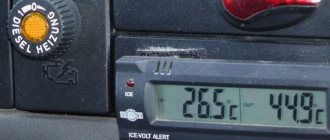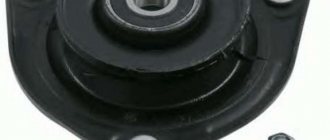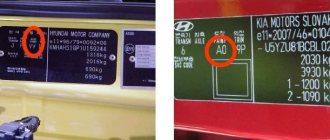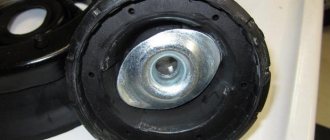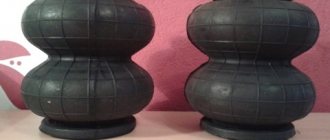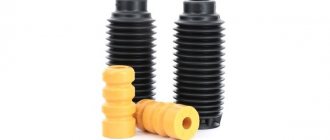Hi all! When shock absorbers are used on a car for a long time, they gradually wear out and need to be replaced. At the same time, changing the node includes some important nuances. If you decide to take on the job yourself, you definitely need to know how to bleed shock absorbers before installation and do it correctly.
Before we get started, I advise you to read our recent article, which discussed the front shock absorber struts. I'll leave the link here. Go ahead, read, get new useful information.
Pumping is considered a key condition for proper installation and further effective operation of the unit. If you do not do this, the part will fail. Moreover, such a malfunction does not fall under the terms of the warranty case. Everything will have to be corrected at your own expense.
Why is pumping done?
Not everyone understands why pumping is done and whether it is necessary at all. Some clarity should be provided on this score in order to finally understand the meaning of pumping and the urgent need for such a procedure.
The working mechanisms of shock absorbers include special sleeves in their design. If air gets inside them, then the device will not be able to return to its original position. Moreover, before installation, air must be removed from new and old parts if you suddenly bought used shock absorbers because their price turned out to be lower. It cannot be ruled out that during the suspension repair process or during troubleshooting, air penetrated inside the mechanism.
During storage and transportation, the oil included in the shock absorber penetrates the outer cylinder of the structure, which is why the gas ends up inside the system. This phenomenon leads to the fact that after installing even a new part, a knock is heard.
By performing special actions, excess air is removed from the cylinder. This is done immediately before installation.
And it is still relevant to ask why this is being done. Everything is extremely simple. To ensure correct, efficient and long-term operation of new shock absorbers installed as part of a dependent or independent suspension.
Important nuances of proper pumping
Currently, an impressive number of different automotive shock absorbers are sold, including:
- Kayaba;
- Monroe;
- Phoenix;
- Demfi;
- Bosch;
- Sachs;
- SS20, installed mainly on VAZ;
- Febi;
- Boge;
- ASM;
- Delphi;
- RTS, etc.
In reality, bleeding shock absorbers yourself is not that difficult. You just need to know about some basic nuances, general recommendations, and also take into account the type of part. Each variety has its own special instructions. You can easily emphasize a lot from the video tutorial on leveling up.
Often, you don’t even need a special tool. The main thing is to have gloves at your disposal to prevent damage to your hands and also to protect yourself from contamination.
As for the general rules, they are approximately the following:
- After bleeding and immediately until installation, the shock absorber should be kept strictly in a vertical position;
- If you turn the element over, air will get inside again;
- Some shock absorbers require draining the oil;
- The bleeding procedure largely depends on the type of part used;
- The oil can be drained by dropping the piston into the lower part of the structure, without pressing about 30 mm;
- An alternative option is to use a special groove provided by the manufacturer.
In addition to general recommendations, be sure to refer to the instructions that are relevant for a specific type of car shock absorber.
Pumpable types of shock absorbers
Surely you know that shock absorbers are divided into oil, gas and gas-oil. All of them are quite actively used in the design of vehicles.
In this case, pumping is required for all categories of suspension units:
- front shock absorbers;
- rear;
- new parts;
- used;
- original;
- analog;
- single-pipe;
- two-pipe;
- collapsible;
- non-separable.
As you can see, it doesn’t matter what kind of shock absorbers we are talking about. All of them are subject to preliminary pumping before installation. Let you have at your disposal an ordinary old Gazelle or a brand new Audi. Although owners of expensive cars often prefer to have their car serviced at a car service center. But that’s not about that now.
Although it is not fundamentally important whether the shock absorbers are rear and new, or front and used, special attention should be paid to the specific type of element. Gas, oil and gas-oil shock absorbers have their own instructions. Relying on them, you can pump the part with your own hands, and the rack will work for a long time, efficiently and effectively.
Gas shock absorbers
Let's start with pumping these particular shock absorbers. The gas most often used here is nitrogen. It's not difficult to upgrade them. You just need to follow a certain sequence of actions:
- Turn the assembly over so that the rod is pointing down toward the floor;
- Now slowly begin to compress the shock absorber;
- After squeezing, hold it in this position for a few seconds;
- Then turn the part the other way around;
- Hold the rod clamped for 4-5 seconds;
- Pull the rod back until it stops;
- Turn the shock absorber over;
- Leave the element in a horizontal position and install it on the car.
At this point, pumping is considered complete. Like I said, nothing complicated. Take your time, but also try not to keep gas-type shock absorbers in a compressed state for more than 6 seconds.
Oil shock absorbers
In the case of such car shock absorbers, the procedure is somewhat different. It is extremely important to strictly follow the given algorithm. The more accurately you follow the instructions, the higher the likelihood of doing everything as correctly as possible.
- Place the shock with the rod down, as in the case of gas elements;
- Smoothly compress the shock absorber until it stops;
- Having completed the compression, do not release the part and hold for 2-3 seconds;
- Without releasing the rod, turn the shock absorber over;
- Hold in a compressed state for up to 6 seconds;
- At this time, the air should come out;
- Then pull the rod out all the way;
- Turn the shock upside down;
- Wait about 3 seconds, and perform similar manipulations at least 3 times.
Although it is believed that the optimal number of such approaches for oil-based automobile shock absorbers is 6.
When you reach the third pumping, be sure to perform the so-called control action. It consists of the following:
- turn the shock absorber so that the rod points upward;
- make several short but sharp compressions of the rod.
In this case, the movement of a properly pumped shock absorber must be as smooth as possible, without dips or jerks. If this occurs, you need to repeat the pumping procedure.
Gas-oil
If you have not had any problems checking the shock absorbers for performance, then you can easily cope with this task with your own hands.
Gas-oil elements must be pumped immediately before installation. There is virtually no point in doing such a procedure in advance.
- Turn the stand over so that the cylinder is facing up;
- Compress the shock absorber and hold it in the compressed position for 3-4 seconds;
- Turn the element over without releasing the part;
- Slowly and gradually begin to extend the cylinder to its starting position;
- Repeat the same procedure at least 3-4 times;
- Between approaches there is a break of just a few seconds;
- Do not turn the shock over after bleeding is complete.
If you accidentally drop or overturn an already pumped gas-oil shock absorber, you cannot install it on the car. First, be sure to repeat the previous prevention and preparation.
When for some reason you are unable to bleed the shock absorbers, you are not confident in your abilities, or you feel extraneous sounds coming from the suspension after replacing parts, it is better to seek help from qualified specialists.
I think we can end here. If you have questions, be sure to ask them in the comments. And also share your personal experience on pumping shock absorbers yourself. Perhaps you can give some practical advice.
Thank you for your attention! Subscribe, leave reviews, invite your friends and acquaintances to join us!
( 5 ratings, average: 4.20 out of 5)
Devices called shock absorbers are one of the main parts in the transmission of our car. Without these devices, driving would be extremely uncomfortable, since the car body was subject to constant rocking, and this “swinging” became permanent. A shock absorber is a kind of “muffler” of these swings; they dampen the swing of the springs installed on the car while driving, in addition to them also springs and torsion bars. The entire body of the transmission is distributed in such a way that the height of the springs on the car always remains at a certain value, vertical to the road surface. In this regard, all four wheels of the car have the same connection with the road surface, and this does not depend on whether the wheel is located on a hillock or in a hole. Let's assume that the car does not have shock absorbers installed, and the springs and wheels are given complete freedom of action. What could happen in this case? The contact of the car wheels with the road surface is not constant this time, and, consequently, the communication of the wheels relative to the transmission, as well as the wheels move chaotically relative to the car body. In this situation, the driving process itself will turn into a complete nightmare; believe me, it’s easier to walk at a pace in this situation. If the car begins to “bounce” at low speeds and the driver cannot control the car, then we can safely say that some shock absorber has failed. Based on this case, we can safely conclude that the shock absorber is a “muffler” for improper operation of the springs and a guarantor of constant contact of the wheels with the road surface.
Shock absorbers are pumped under various conditions, but the main thing is a hard floor and skillful hands.
Shock absorber classification
Undoubtedly, the shock absorber, as part of the chassis system, is its main component.
Without it, moving inside a car would turn into a trip on a sea liner - continuous vertical swaying would negatively affect both the ride quality and your vestibular system. In simple words, a shock absorber is a kind of damper that prevents vibrations in the car due to the operation of springs and springs. Also, without shock absorbers, the car would lose continuous contact with the road surface. This is all due to the incessant swinging of the springs. It is difficult to find a car owner who is not familiar with this situation, when the car begins to “bounce” on a trifling bump, and when driving at a speed of 20-30 km/h, the control of the car becomes less responsive. These are the symptoms that indicate a faulty shock absorber.
As for the types of shock absorbers, here things are as follows. All currently existing modules can be divided into two categories: oil and gas. In addition, all shock absorbers can be divided into single-tube and double-tube (if you do not pay attention to the various pneumatic settings).
How to bleed shock absorbers?
Before installing this device on the car, it must be bled. If you install it right away, the shock absorber piston system is 100% likely to break, which in turn will lead to failure of the new struts. Both front and rear shock absorbers need bleeding when installed on a car. Please read the instructions included with them before installing them.
If you decide to install a shock absorber without bleeding and it fails as a result, this is not considered a warranty case. This event will occur because air will somehow remain in the inner sleeve - which will interfere with the correct operation of the shock absorber and will not allow it to perform its original functions. It is quite simple to understand a broken shock absorber; you will hear a loud knock of the strut or extraneous noise will appear during its operation.
Let's consider this type of shock absorbers as twin-pipe. As was said earlier, before installing it, it should be pumped. While it is being stored or before being transported, the liquid component of this device may flow chaotically from one cylinder to another and vice versa. With this arrangement of affairs, gas is formed. If you do not pump the shock absorber and install it, then this gas will render the throttle valves of the device unusable and they, as a rule, are destroyed. Therefore, when installing, the shock absorber simply needs to be made operational or, as they say, “pumped.”
The instructions for pumping devices are literally as follows:
- Take the device in your hands so that the rod component of the shock absorber is in the lower plane, and gently squeeze it.
- Freeze in this manner for five or seven seconds.
- Without allowing the rod component to shift in this position, turn the device one hundred and eighty degrees and freeze for five or seven seconds.
- As soon as you complete step three of these instructions, remove the rod all the way.
- Holding the rod device in the upper plane, you need to squeeze it six times in a row. If at the same time the rod fails or it is difficult to “move”, then turn the device over one hundred and eighty degrees again and follow step one of these instructions.
- As soon as you complete points one to four of these instructions. Holding the device so that the rod component is at the top, you need to perform one control action. That is, you need to make sure that the piston extends the rod from one end to the other freely.
Properly pump the shock absorber - ensure that the piston component does not fail when moving from one position to the second and vice versa. After pumping the device, you need to take it so that the rod is at the top and keep it in the indicated position until it is completely installed on the vehicle.
How to bleed a shock absorber strut?
- The first thing you need to do is place the stand on a hard surface (for example, it could be a concrete floor), the rod should be strictly in the lower plane and begin to smoothly compress it.
- Squeeze and wait in this position for five or seven seconds.
- Having turned the device one hundred and eighty degrees, placing the rod in the upper plane, pull it back, provided that it has not returned to this state on its own.
- Then, leaving it in this position for five or seven seconds, repeat the operation, starting from the first point.
Something to remember! In any case, shock absorbers are pumped before installation on the car. Depending on the types of shock absorbers, the technology for pumping them remains almost unchanged.
Before pumping the oil shock absorber, let's look at its structure.
Twin-pipe hydraulic shock absorber. This shock absorber is, as a rule, the simplest in its design and the cheapest when considered relative to price. The main disadvantage of this type of shock absorbers is its instability in operation. It consists of the following components:
- A cylindrical surface in the form of a fuselage (or otherwise a tank).
- Cylinder for work (working cylinder).
- Valve for forward stroke or compression. It stands in the working cylindrical surface.
- Piston component (aka piston).
- The valve or bumper, in turn, into the piston component itself.
- Rod component.
- Shock absorber cover.
Let's look at how our shock absorber works:
The cylindrical surface located in the device cover (shock absorber) is also, among other things, a reservoir that is filled to the mark with oil. The piston component and rod are located in the working cylinder of the device. The device is based on this principle - upon compression, the piston component and the rod component move down and displace liquid (oil) from the cylindrical surface into the device body. The air component located at the top comes to compression. If the process happens the other way around, then the bumper plays the role of “passing” liquid from the device body into the cylinder. From this operating principle we can conclude that the design of the device is made in such a way that the shock absorber is built extremely simply. Everything would have been done to perfection if the hydraulic shortcomings of this device design had not interfered. As you know, when hydraulics operate, heating occurs and, based on physical laws, the compensation component of all springs flows into heat and the liquid heats up. Due to heating of the liquid (oil), a problem occurs. The two-pipe design itself will not interfere with heating the liquid, but what to do with its cooling? The problem of oil not being able to cool causes it to foam. It will not be possible to overcome this problem; car enthusiasts are making attempts to get rid of this problem by filling the shock absorber to capacity. This is the wrong approach, since a shock absorber filled to capacity with oil will deteriorate over time due to this. Aeration is a frequently occurring problem, and one has to put up with it, since there is no other way out of the situation.
Gas devices, like their liquid designs, are pumped according to the same principle and in the same order. Here, gas is used instead of liquid (oil). When using a gas device, it is assumed that the gas itself passes through a small hole that exists between several chambers; in this case, it is quite difficult for the gas to move between them especially quickly. Due to this, the rod cannot return sharply down or return quickly to its place, so the car moves smoothly. Gas is pumped in very slowly and under enormous pressure. This ensures the slow operation of the rod itself in the device.
Bleeding gas-oil devices.
This device is generally called a "gas-oil" device. If we talk about assembling the structure of this device, then there are practically no differences from assembling hydraulic devices. The only difference is that instead of liquid, gas is pumped in (nitrogen is often used), instead of an air mixture. In this assembly, the gas itself acts as a high-pressure accumulator; it prevents the liquid from foaming. At the same time, it creates another problem - the liquid foams. If you buy a gas-powered device in a store, it is quite easy to distinguish it from others. The rod part of this device is always trying to come out.
Single-pipe gas device in the form of a shock absorber.
This type of device is always very popular among car enthusiasts. But these structures also have liquid; fortunately, it does not come into contact with gas. This device differs from the one described above in that it has the following components in its “clip”:
- Frame.
- Rod component.
- The piston component, in turn, is connected to the rod component and has several valves.
- A special piston component called a “float” is what separates the liquid from the gas chamber.
It does not have a working chamber; this role is played by the body of the device. Single-pipe devices are divided into several parts using the same “float”. Gas is pumped into the lower part under enormous pressure, while the upper part is filled with liquid in which the piston and rod components of the structure move. The working chamber was simply removed from this device. The valves are located “neighborhood”. This single-pipe design allows you to increase the volume of gas many times, while the design itself does not change its size. This device can almost be called perfect, and since the liquid and gas are separated, the former no longer foams.
Among the new developments for these devices, we can highlight a brand that was created. According to the scheme, this device is not too different from a single-pipe device, except for the fact that a special liquid component is poured. The liquid component contains magnetic particles. The magnetic field acts on the liquid and it itself changes its own viscosity. This effect occurs in an instant, so the car’s wheels immediately have time to adjust to the road surface. This device has been quite well tested and installed on cars such as the Chevrolet Corvette and Cadillac Saville. Provided that they show themselves on the positive side in the future, there is a high probability that soon all cars will have shock absorbers with this liquid. The only drawback is that the cost of this liquid is currently too high.
There should be no air in the working area of the inner shock absorber sleeve. If the shock absorbers were not pumped before installation, this will result in incorrect performance of the functions. The device begins to knock, make noise, and then jams. Therefore, any rack should be pumped before installation, and this should be done according to the manufacturer’s recommendations.
How to bleed shock absorbers, rules and technology for pumping oil shock absorbers
Which shock absorbers are better to install on a Chevrolet Aveo
Hello, dear car enthusiasts! Do you know the difference between a good auto shop and a bad one? A naive question, but for many car enthusiasts, the question that the seller asks when buying shock absorbers saves money.
And this question is simple and unpretentious. Will you install the shock absorbers yourself or will they be installed at a service station? - This is exactly what a sales consultant asks in a good car shop.
If you answer that you will install the shock absorbers yourself, then the seller will give you a long “instruction sheet” on how to properly bleed the shock absorber before installing it on the car.
Well, if the installation is carried out at a service station, then the technician will know how to bleed the shock absorbers. But, you should also know that bleeding shock absorbers is a mandatory procedure, and, naturally, have an idea of how to properly bleed a shock absorber.
Why is it necessary to pump shock absorbers before installation?
Let's start with the fact that if a standard twin-pipe shock absorber is not pumped before installation on a car, this can serve as almost the main reason for the failure of the piston shock absorber. And, in this case, the product warranty will not apply. That is, your money will be lost.
Pumping of oil shock absorbers is carried out in order to bring it into working condition, namely:
- so that air (pressure gas) or oil does not remain in the inner sleeve of the shock absorber, which leads to a malfunction of the shock absorber;
- detect possible jamming of the shock absorber valve mechanism, or any other malfunctions;
You should be aware that if there are not very significant dips in the resistance of the valve mechanism or a slight difference in the speed of the rod exit in the gas-oil shock absorber, this is not considered a malfunction. Such deviations do not affect the overall performance of the shock absorber.
General rules for bleeding shock absorbers
- shock absorbers are pumped in the rod position up, that is, vertically;
- after you have pumped the shock absorber, it must be kept with the rod up, in a vertical position, until it is installed on the car;
- Some shock absorber designs include a mechanism for draining oil. Methods: either by sinking the rod into the shock absorber, or by using a technological groove located at the top of the rod. In the first case, the shock absorber rod should be left uncompressed by 2-3 cm. In the second case, the rod is compressed to the technological groove on it.
How to properly pump oil shock absorbers
MacPherson struts and cartridge struts are typical for modern cars. That is why, using their example, we will consider the technology of pumping the shock absorber.
- We turn the shock absorber down with the rod and without jerking, smoothly compress it;
- Fix the shock absorber in this position for 2-3 seconds;
- Holding the shock absorber rod, turn it upside down and fix it in this position for 3-6 seconds;
- Then, until the end of the stroke, we smoothly extend the rod;
- We turn the shock absorber over again with the rod down, pause for 2-3 seconds and repeat the operation. The number of approaches can be from one to six.
During the third pumping approach, it is necessary to carry out a control action, namely: the shock absorber is in the position with the rod up, with sharp, short movements we make sure that the rod moves smoothly. The piston movement should be smooth, without failures.
If everything is in order and the movement of the shock absorber rod is smooth, then bleeding of the shock absorber is completed and it can be installed in place. We perform similar bleeding operations with other shock absorbers before installation on the car. It is not necessary, but it is recommended to change shock absorbers in pairs, that is, on one axis at the same time.
Do I need to bleed shock absorbers before installation?
Gas remaining in the shock absorber, like air, is a common cause of knocks and noises during chassis operation. Therefore, it definitely needs to be pumped. If the requirement is not met, extraneous knocking and noise appears during the first ten thousand kilometers, which only intensifies over time. The suspension will begin to function with minor dips. “Death” marks jamming.
Do I need to bleed the struts before installation? Necessarily. Otherwise, the shock absorber rod, like the piston system in general, will not be able to fully perform its assigned tasks. At best, you will have to buy a new set of struts; at worst, this will lead to a traffic accident.
The shock absorber is stored in a warehouse in a horizontal position. This is due to the need to maintain the performance of the oil seals through constant contact with the lubricant. Long-term storage leads to spontaneous flow of liquid into the outer cylinder, and the freed volume is filled with air. The result is a partial loss of performance. That is why the driver needs to bleed the strut with his own hands.
Pontiac Vibe is a good car Logbook How to properly bleed shock absorbers before installation
NOT mine, taken from the site www.nissanoteka.ru/nt/Ins…rtizators_KAYABA_EXCEL_G Instructions: correct pumping of KAYABA EXCEL G shock absorbers Good afternoon guys! Maybe someone will find these instructions useful for correct pumping of Kayaba Excel G shock absorbers (twin-pipe gas shock absorber). Text translated from original Kayaba installation instructions
ATTENTION ! Failure to bleed a twin-tube shock absorber before installation is a common cause of failure of the shock absorber piston system. This is a gross violation of the installation instructions and a likely reason for the case to be out of warranty! If there is residual air in the inner liner of the shock absorber, the shock absorber will not perform its function properly.
Malfunctions lead to knocking, noise during operation of the shock absorber and its probable failure. New shock absorbers from the factory may have air bubbles in the shock absorber piston system.
Based on long-term experience, the company's designers and engineers have prepared recommendations for pumping the shock absorber: Before installing a twin-tube shock absorber on a car, it must be brought into working condition. During storage and transportation, in twin-pipe shock absorbers, liquid can flow into the outer cylinder from the inner one, while gas enters the working cylinder (inner). In this case, its throttle valves will be destroyed and the shock absorber will produce extraneous noise and knocking when operating in a car suspension. To avoid shock absorber malfunctions, it must be pumped before installing it on the car. To do this: 1. The shock absorber should be turned upside down and compressed slowly, without sudden movements;2. In this position, the shock absorber rod must be fixed for 2-3 seconds;3. Without releasing the rod, you need to turn the shock absorber over with the rod facing up, and fix the shock absorber in this position for about 3-6 seconds;4. After 3-6 seconds and leaving the shock absorber in a vertical position, smoothly extend the rod until it stops (end of stroke);5. Next, you need to position the shock absorber with the rod down, pause for 2-3 seconds. and repeat the operations of points 1, 2, 3, 4 approximately 5-8 times;6. When bleeding the shock absorber, following the entire above sequence, stop at points 4;7. Holding the shock absorber in a vertical position, with the rod up, perform the last, let’s call it, control operation (with sharp movements you need to press the shock absorber rod a little at a time and with proper pumping, the piston should move smoothly and without failures). If the shock absorber is pumped correctly, the piston moves smoothly, without dips. After pumping is completed, the shock absorber must be kept in the working position, VERTICAL and ROD UP, until final installation on the car. After bleeding, in no case should you tilt or turn the shock absorber over before installation. Many people install the shock absorber directly out of the box, without proper bleeding, the service life of the shock absorber in this case is reduced by 3-5 times, and the shock absorber cannot perform its functions normally (does not work correctly )
ps You might notice that if the shock absorber was inoperative for a long time (stored) in a lying position, the rod may move with jerks and shocks.
I will be glad if this instruction helps someone, I think not everyone here installs an expensive original, if you follow these instructions you will really notice a positive effect. Good luck on the roads!
Bleeding rear shock absorbers before installation
Bleeding is an easy procedure; new shock absorbers do not need to be sent to a service center. To properly pump the device, you need to follow this sequence of actions.
- Install the stand with the stem down. The base must be solid, ideally a concrete floor.
- Smoothly compress the product.
- We fix the position for two seconds.
- To get the rod back, you need to turn the shock absorber over and pull the tube out manually. Usually the rod rises without outside help.
- Leave the rod in the extended position.
- We repeat the procedure two or three more times.
After this, the rear struts can be installed on the lever or axle of the car.
How are gases pumped?
The algorithm for working with shock absorbers filled with special gas is as follows:
- The part is turned over with the rod towards the ground.
- After this, you need to smoothly compress and fix it for several seconds.
- After completing the procedure, you need to turn the part over; you must hold it there for no more than 6 seconds.
- The next stage is to extend the rod all the way;
- The final stage is turning the shock absorber over.
Differences in the operating principle of hydraulic and gas shock absorbers
If possible, it is worth familiarizing yourself with the video recording of pumping parts of this design in advance.
How to bleed an oil shock absorber before installation
As mentioned earlier, everything, including oil shock absorbers, must be pre-bleeded before installation. The operating instructions supplied by the manufacturer indicate the correct sequence of actions.
- Vertical placement of the rack, the rod should be in the upper part.
- Recess the rod into the cylinder using little effort (your own weight is enough). You should leave a margin of three to four centimeters above the cut.
- Fix the device in the obtained position for four to five seconds.
- Smooth extension of the rod from the cylinder.
- Repeatedly turn the rack into a vertical position, pumping three or four times according to a similar principle.
That's all, the oil shock absorber can be installed on the car. According to my own observations, pumping automobile oil shock absorbers has the simplest principle.
We pump original oil shock absorbers of Lada Priora
These bleeding methods are suitable for most shock absorber struts installed on domestic cars, including the VAZ 2107.
Doing the work manually is not easy, but it is possible
Please note that the front shock absorbers on the Priora are not replaceable and are not suitable for other models, especially the VAZ 2110, they have different springs
There are two methods of pumping, without turning over and with turning over the shock absorber strut.
But there are general recommendations that must be followed in all cases.
- When pumping, the shock absorber should be in a vertical position, and if tilted, then no more than a few seconds;
- Bleeding must be carried out immediately before installation on the car;
- Do not use a tool that can damage the product (gas wrench, hammer, pliers), hydraulics is a delicate matter, remember this;
- Do not allow the rod to rotate in the stand itself around its axis;
- Apply efforts smoothly, without jerking;
- An already pumped shock absorber must be in a vertical position at all times.
Method 1
Place the shock absorber strut on a level place with the lug facing down.
The task is to fully extend the rod when pumping at least 10 times and return it back, thereby ensuring that the liquid (oil) evenly fills the working space.
It is difficult to pull the rod out by hand, so they come up with different devices.
In our case, you can take a 30mm adjustable wrench with a hole in the handle whose diameter just allows you to use the tool as a lever.
Place the key on the rod so that the threads do not touch and take it to the break.
Do not sharply, using even force, pull it out until it stops.
We return it back smoothly, without any jerks.
The latter should go down easier than up, the ideal case is when the lowering occurs under its own weight. But if the rod does not fall without influence on it, this is not scary.
We repeat the steps cyclically at least 10 times, pay attention to possible jerks when retracting and pulling the stand, extraneous sounds and gurgling. Their presence is allowed at the beginning and middle of the procedure, but at the end of pumping they should not be present.
If necessary, increase cycles to 15 – 20 times
Their presence is allowed at the beginning and middle of the procedure, but at the end of pumping they should not be present. If necessary, increase cycles to 15–20 times.
The rear suspension struts on Priora are interchangeable; the rear strut from VAZ 2110, 2111, 2112, Lada Samara, Granta, Kalina will fit here.
Using the same wrench to 30 we pump up the rear shock absorber.
Please note that the rear strut does not come with a bolt, which increases the likelihood of thread damage
Temporarily screw in any other bolt there or perform bleeding with extreme caution
Temporarily screw in any other bolt there or perform bleeding with extreme caution. Insert a rod (you can use a large screwdriver) into the lower part of the hole to hold the stand with your feet
Insert a rod (or a large screwdriver) into the hole at the bottom to hold the stand with your feet.
After pumping, the shock absorbers can be installed in the garage with your own hands, but since this is quite labor-intensive work, many people prefer to do it at a service station.
To prevent the devices from turning over to a horizontal position, they can be placed in factory boxes, twisting the latter with tape.
Method 2
The oil shock absorber is pumped according to the following algorithm:
- The rack rod must be positioned so that it is extended to 75% of its length;
- Turn the shock absorber over with the rod down and rest the latter on the floor;
- Applying even force, press the rod until 4-6 cm remains to the rack body. Wait 5-6 seconds.
- Turn the device over, wait 5-6 seconds again, and pull the rod out to 75% of its length. Break – 2-3 seconds.
- Press the rod in again.
Carry out the operation 6 to 10 times, and on the third and sixth repetitions, try to move the rod with sudden efforts, which in any case should move smoothly. If not, the procedure continues.
Bleeding gas-oil shock absorbers
Bleeding automobile gas-oil shock absorbers has a different preparation technology that allows you to bring the device into working condition.
- Place the device in a vertical position, the rod must be at the bottom and must rest against a flat surface.
- By applying a little force, you need to compress the stand without jerking.
- Fixation in the obtained position for two to three seconds.
- Reversing the shock absorber. Important - under no circumstances should the rod be released for three to six seconds.
- Release of the rod.
Bleeding gas shock absorbers
The main working substance inside the piston is gas. Drivers often ask how to properly prepare gas shock absorbers for installation. Answer: no, the need for preliminary preparation is not provided for by the manufacturers. And this is despite the comments of “experts” on the Internet.
Why is that? There is a floating impenetrable piston inside, which is responsible for separating the working environment. It is under constant “calm pressure”, which does not allow the gaseous substance to pass into the second chamber. Triggering occurs when the load on the suspension increases - for example, when a wheel suddenly falls into a hole on the road. Therefore, pumping of automobile gas shock absorbers is not necessary.
How to pump up struts with your own hands that were already on the car
If over time the car begins to behave on the road differently than before, it is necessary to check the condition of the suspension. To do this, the strut is removed from the spring and then checked. Used copies also need pumping, even if the seller assures that everything is fine with them and they do not need additional manipulations.
The principle of performing the work remains the same. But the main attention is paid to the behavior of the rod when returning to its original position. If even after 6-8 up and down movements the rack works in the same way, this indicates its severe wear. There is no need to install it on a car. There are two options - buying a new set, or handing it over to a specialist for restoration.
Bleeding gas-oil cartridges and racks
Bleeding the front struts is performed in the same sequence - turn the rod down, compress it, then pull it out manually and repeat the procedure again two or three times.
That's all, the front shock absorber is prepared, next is installation.
If over time the car begins to behave on the road differently than before, it is necessary to check the condition of the suspension. To do this, the strut is removed from the spring and then checked. Used copies also need pumping, even if the seller assures that everything is fine with them and they do not need additional manipulations.
The principle of performing the work remains the same. But the main attention is paid to the behavior of the rod when returning to its original position. If even after 6-8 up and down movements the rack works in the same way, this indicates its severe wear. There is no need to install it on a car. There are two options - buying a new set, or handing it over to a specialist for restoration.
Another useful video from the experts with tips on correctly pumping racks.
The pumping process is not difficult. No special tools required. Just gloves will be enough to protect your hands from injuries and dirt. First, you should familiarize yourself with the general rules for its implementation:
- after completing the procedure, until the very moment of installation in its place, it is necessary to keep the part vertically - otherwise air may again get into it;
- It is important to consider the need to drain oil from some shock absorbers.
Shock absorbers can be either single- or double-tube, and there are also struts with a remote chamber
You can perform draining in different ways:
- by sinking the piston into the lower component of the part (there should be an undercompression of approximately 3 cm);
- through a groove designed for this purpose - it is usually present in the upper part of the part.
Gas-oil shock absorbers are pumped using a similar technology:
- Install the shock absorber with the rod up, smoothly recess the rod, but leaving a distance of 20 mm between the working edge and the edge of the glass.
- Allow the shock absorber to settle for five seconds.
- Smoothly move the rod to the maximum level.
- Repeat the operation several times until the dips disappear and the operation of the device becomes uniform and smooth.
As you can see, there is nothing complicated in preparing shock absorbers; the main thing is to carry out pumping as smoothly and slowly as possible.
What happens if you don’t bleed the shock absorber before installation?
The procedure discussed is necessary to put the shock absorber strut into working condition. This provides:
- comprehensive removal of residual lubricant or air from the space of the inner sleeve. Failure to follow this procedure will lead to failure of the shock absorber unit after 10-15 thousand kilometers (sometimes earlier);
- early detection of defects and potential malfunctions in box shock absorbers, expressed in the form of sticking of the valve block.
Note! According to the experts who service the suspension at service centers, it is enough to pump the unpacked shock absorber three times. In their opinion, a one-time pumping is not enough to bring the part back to life.
When installing a new shock absorber without preliminary pumping, after 3-5 thousand kilometers, an incomprehensible noise and knocking will occur. After another 5-7 thousand kilometers the strut will jam. It is unlikely that it will be possible to return it to good condition.
Let us inform inexperienced drivers: only twin-tube shock absorbers require bleeding. The exception is a single-pipe new copy. The operating principle is designed so that the oil does not enter the gas chamber, because the latter is under high pressure. The result is that excess air cannot accumulate. A sealed piston is responsible for this, separating the two media from each other.
If you accidentally pump a single-pipe product, it will not damage it. Young owners who do not understand the difference between a single-pipe and a two-pipe device should still do control pumping. On the one hand, this will not harm the single-pipe design. On the other hand, this will take at most five minutes of free time, and it will be possible to avoid potential malfunctions in the future.
Bleeding is a simple procedure that does not require contacting a service station technician. By following the rules, the device will last its entire operational life.
During transportation in gas-oil suspension dampers, liquid and gas flow from one pipe to another, which leads to disruption of normal operation. A car owner involved in self-repairs needs to know how to bleed shock absorbers before installation and why this is necessary. The algorithm for preparing the rack for operation is indicated in the factory instructions.
Watch the video
How to bleed shock absorbers?
New shock absorbers must be bled before installation. This is explained by the fact that there is air in the inner sleeve of the device, which must be pushed out for the proper functioning of the car struts. Otherwise, a malfunction of the mechanism may lead to its rapid failure.
Why is pumping necessary?
Pumping gas-oil shock absorbers is necessary for normal distribution of gas and working fluid between the cylinders. When transporting or storing new two-pipe racks in a horizontal position, some of the oil leaks from the inner cup into the outer container. At the same time, part of the gas pressure passes into the internal element.
The pumping procedure allows you to redistribute liquid and air through the valves present in the design, ensuring normal operation of the product.
Single-pipe type devices used in rear suspensions do not require preparation before installation. The rack design uses a metal cylinder, which is divided by a piston and a rod into 2 compartments. The gas chamber is filled with nitrogen at high pressure, which prevents oil from entering or flowing into the liquid compartment. Carrying out pre-installation preparation of a single-pipe rack does not harm the structural parts.
What happens if you install the shock absorber as is?
If a 2-pipe rack is installed without prior maintenance, then extraneous noises or knocks appear during operation. Exposure to a mixture of gas and air negatively affects the bypass valves, which fail after 5-7 thousand kilometers. Since bleeding recommendations are indicated in the instructions or on the packaging, failure of parts due to installation errors is not covered by the warranty.
KYB recommends bleeding the racks before installation for the purpose of an initial check of functionality. The manufacturer has provided an additional valve in the design of the shock absorbers, which transfers liquid and gas between the working chambers after the unit begins operation. To bring the part back to normal condition, the car must drive on a standard paved road for up to 300 m. Other manufacturers of suspension dampers do not use a similar valve; pumping of such shock absorbers is mandatory.
What can happen if you install an under-inflated shock absorber?
If you've read about the structure of a car's shock absorber, you should know why pumping is needed.
During transportation, air or gas that remains in the shock absorber prevents the entire mechanism from working properly, which can cause unnecessary knocks and noises during suspension operation. In extreme cases, suspension failures or jamming may occur. Also, the procedure for pumping the shock absorber is good because during its execution you can find some breakdowns of the mechanism, be it factory or others. The pumping process itself is a fairly simple procedure and does not require a lot of time or special skills, you just need to follow a few important points:
If you want to install an oil shock absorber strut, then bleeding will consist of the following steps
:
- Install the new shock absorber strut vertically, the rod should be at the top;
- Press the rod so that it sinks into the cylinder, but 3 cm of the working part should remain on the surface;
- Hold in this state for several seconds;
- Pull the rod out of the cylinder all the way;
- Repeat this operation 3-4 times. Do not press the shock absorber very hard, everything should happen easily and smoothly
Step by step pumping technology
There are several types of shock absorbers, which differ in the aggregate state of the working substance and the pumping method. On cars, gas-oil type racks can be used (air or nitrogen pressure in the working chamber is 2-3 atm.). There are also oil dampers, which are characterized by low efficiency due to the rapid heating of the liquid. Gas elements contain an inert gas (for example, nitrogen) inside, pumped under high pressure.
Bleeding is also performed when installing used shock absorbers, since it allows you to determine the degree of wear of the part. When checking, the behavior of the rod when returning to its original position is analyzed.
For example, when hitting high bumps, a shock load occurs, leading to the loss of part of the gas from the reservoir. The residual air or nitrogen pressure is not enough to quickly and smoothly return the rod to its original position. It is not recommended to install damaged suspension elements on a vehicle.
Gas-oil design
recommends performing preliminary maintenance of the front struts according to the following algorithm:
- Unpack the product, and then turn the damper upside down.
- Place the rod against a piece of board, pause for 3-5 seconds, and then use your body weight to compress the shock absorber until it stops.
- Hold the stand in a compressed state for 2-3 seconds.
- Rotate the assembly 180° (not allowing the rod to come out again) and hold the part in a vertical position for 4-6 seconds.
- Reduce the force, achieving a smooth exit of the rod from the pipe. In this case, the body should not be tilted to the sides.
- Press down on the working rod. A piece of board is used to press; the rod should move up and down without jerking or dips. It is recommended to carry out 5-8 cycles analyzing the performance of the shock absorber. If jerks are detected during movement, then you need to turn the part 180° again and perform compression and hold for 3-5 seconds.
- Carry out a test check by exerting sharp impacts on the operating rod. The piston must move smoothly inside the pipe; sticking and jerking are not allowed. If malfunctions are detected, it is recommended to return the product to the store. Incorrect stroke of the piston and rod after pumping indicates manufacturing defects.
The prepared rack is held in a vertical position until it is installed on the vehicle. If a part falls or is temporarily stored in a horizontal position, the preparation cycle is repeated. Using a similar technique, two-pipe type damping elements from other manufacturers are pumped.
Hydraulics on oil
To prepare oil racks with your own hands, you need to:
- Remove the packaging elements from the body, and then extend the rod to 75% of the working stroke. If the product is supplied in a loose state, the rod must be pressed into the pipe by 25% of the length.
- Turn the product over with the rod down, and then gently compress the structure under the influence of your body weight. Manufacturers do not recommend bringing the piston to dead center; 50-70 mm of the rod length should remain from the shock absorber pipe.
- Pause for 3-5 seconds, and then turn the product 180° (without releasing the pressed rod).
- Wait 3-5 seconds, then smoothly extend the rod to 75% of the working stroke.
- After 2-3 seconds, turn the assembly 180° and push the working rod into the rack cylinder. The procedure of sequential compression and release of the shock absorber is repeated 4-6 times. During movement, dips or jerks of the rod are not allowed, indicating incorrect operation of the valve mechanism.
After pumping, a serviceable rack undergoes additional testing. It is necessary to perform several successive clicks on the rod, which should move smoothly. The shock absorber is stored in a vertical position until it is installed on the vehicle.
Gas shock absorbers
If you plan to install gas struts, the pumping procedure consists of the following steps:
- Remove the packaging and safety tapes, and then guide the rod into a board laid on a hard floor.
- Smoothly squeeze the stand, overcoming the force due to your body weight.
- Hold the element in a compressed state for 3-5 seconds, and then rotate the knot 180°.
- Keep the rod pressed for up to 5 seconds, then smoothly extend the rod until it stops. If jamming is noted during movement, then it is necessary to inflate the rack again.
The procedure allows you to check the functionality of the valves. A piston installed in the structure divides the pipe into 2 cavities that do not exchange gaseous substances with each other.
Such shock absorbers can be stored in a horizontal position before installation.
Varieties
If a car enthusiast knows what shock absorbers he knows, then we will get something like this: oil, gas-oil and gas. This answer is partially correct. It is more correct to divide into two types: oil and gas.
This division is based on the use of different working substances. Gas shock absorbers use an inert gas, most often nitrogen, pumped under high pressure. In oil shock absorber struts, hydraulic oil and air or gas are pumped into the working space.
Structurally, they are divided into two types: two-pipe and single-pipe.
The first type of shock-absorbing struts is the most common due to its simplicity and low cost of manufacture. Oil or gas and oil are used as the working substance. The main disadvantage of oil shock absorbers is poor cooling of the working substance. The oil gets very hot due to its small working volume. High temperatures cause the oil to foam and the shock absorber stops working correctly.
Shock absorbers are structurally made into two-pipe and single-pipe. Oil and gas are pumped into the middle
Gas-oil shock absorber struts are partially free of this drawback. Oil and air are pumped into a two-pipe housing under a pressure of 2–3 atmospheres. Sometimes nitrogen is used instead of air. This solution reduces the likelihood of aeration - foaming of the oil.
This is interesting: Bribe to the inspector
Structurally, monotube shock absorbers do not have a working chamber. It is replaced by the rack housing. The tube is divided into two sections. The upper part is filled with oil, and the lower part is filled with high pressure gas. There is a valve between the sections.
Gas shock absorbers are of particular interest to drivers. This is no accident. Gas struts are primarily used in motorsports. For sports driving, this type of rack is most often chosen. The operation of the gas shock absorber is ensured by pumped gas under high pressure. Such racks are the toughest and driving on city roads is accompanied by shocks and impacts. Such a ride cannot be called comfortable, but driving will be clear and controlled. Therefore, gas shock absorber struts are used mainly on racing cars.
A special type of shock absorbers are the so-called “reversals”. They were given this name not because they can be placed upside down. In such racks, the reverse position of the rod is used. In conventional shock absorbers, the rod is directed upward. In inversions, the rod is directed downwards and is attached to the shock-absorbing strut body. There is a pseudo-rod on top. It looks much thicker. The operation of the inverted shock absorber is ensured by several plain bearings. This design reduces the vertical and lateral load on the rack.
Important features of pumping
Before starting pre-installation maintenance of the racks, you must read the instructions, which indicate how to properly bleed. For example, manufacturers of some oil dampers recommend draining some of the fluid from the working cylinder. After pumping is completed, the racks are stored in a vertical position.
It is strictly forbidden to use hammers: if the rod does not move, the shock absorber is considered faulty. It is not allowed to rotate the rod inside the rack housing. During maintenance, do not clamp the rod with a vice or pliers, which damage the surface of the part.


